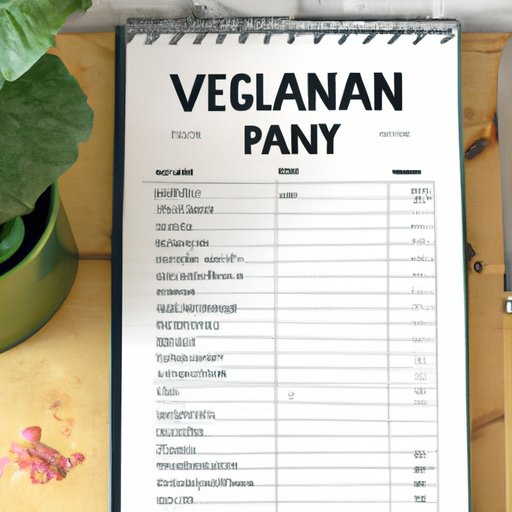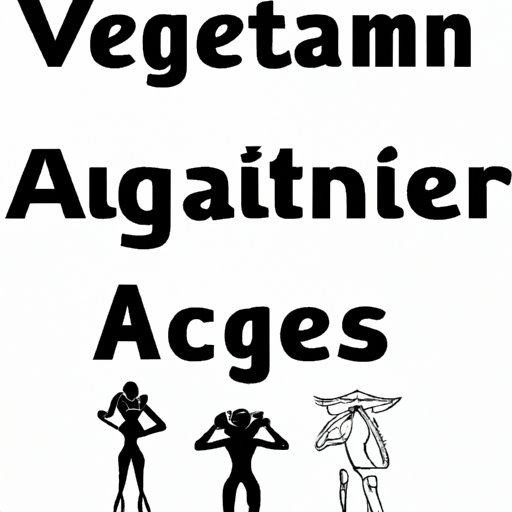Introduction
Veganism is an increasingly popular lifestyle that focuses on avoiding animal products and byproducts, such as meat, dairy, eggs, and honey. This lifestyle has many health benefits, including lower cholesterol levels, improved heart health, and lowered risk of certain types of cancer. In this article, we’ll provide a comprehensive guide to eating vegan, from creating a meal plan to taking advantage of vegan products and recipes.

Create a Vegan Meal Plan
Meal planning is an important part of following a vegan diet, as it helps ensure you’re getting all the nutrients you need while avoiding animal products. Here are some tips for creating a successful vegan meal plan:
1. Focus on Plant-Based Proteins
Proteins are essential for maintaining muscle mass and staying healthy, and there are plenty of plant-based proteins available. Some of the most popular vegan proteins include tofu, tempeh, seitan, beans, lentils, nuts, and nut butters. Incorporating these proteins into your meals will help ensure you’re getting enough protein each day.
2. Include Nutrient-Dense Foods
In addition to proteins, it’s important to include other nutrient-dense foods, such as fruits, vegetables, whole grains, and legumes. These foods are packed with vitamins, minerals, and other important nutrients that can help keep you healthy. Aim to include a variety of different colors and textures in your meals for the most nutrition.
3. Add Variety to Your Meals
Eating the same things over and over again can get boring, so it’s important to add variety to your vegan meal plan. Try experimenting with different cuisines and flavors, such as Indian, Mexican, or Mediterranean, to keep meals exciting. Or, try adding different spices and herbs to give dishes an extra kick.
Learn About Plant-Based Proteins
As mentioned above, there are many different types of plant-based proteins available. It’s important to learn about the different types and how to incorporate them into meals. Here are some of the most popular plant-based proteins:
Tofu
Tofu is made from soybeans and is a great source of protein. It’s also low in calories and fat, making it an ideal choice for weight loss. Tofu can be used in a variety of dishes, such as stir-fries, soups, and salads.
Tempeh
Tempeh is another type of soybean product and is a good source of protein and fiber. It has a slightly nutty flavor and can be cooked in a variety of ways, such as grilling, baking, or sautéing. Tempeh is often used as a substitute for ground beef in vegan dishes.
Seitan
Seitan is a wheat-based protein that’s high in protein and low in fat. It has a chewy texture and can be used in place of meat in sandwiches, tacos, and more. Seitan is often flavored with herbs and spices to give it more flavor.
Find Vegan Substitutes for Favorite Foods
When transitioning to a vegan diet, it can be helpful to find vegan substitutes for favorite foods. There are many vegan alternatives available, including dairy-free milks, cheeses, and yogurts; egg-free mayonnaise and scrambled eggs; and meat-free burgers and sausages. Here are some tips for finding vegan alternatives:
Check the Label
When shopping for food, always check the label for ingredients. Many products, such as breads, cereals, and snacks, are now labeled as “vegan.” Additionally, look for products that are labeled as “dairy-free,” “egg-free,” or “meat-free” to make sure they don’t contain animal products.
Do Some Research
If you can’t find what you’re looking for in the store, do some research online. There are many websites dedicated to vegan cooking and recipe ideas, so you’re sure to find something you’ll love. You can also ask friends and family for suggestions.
Take Advantage of Vegan Products
There are now many vegan products available, from vegan cheese and milk to faux meats and egg replacements. These products can make it easier to follow a vegan diet and can be used to create delicious meals. Here are some tips for taking advantage of vegan products:
Check Out Local Stores
Start by checking out local health food stores or specialty markets. These stores often carry a wide selection of vegan products, from vegan cheeses and ice creams to faux meats and egg replacements. If you don’t have access to a local store, you can also find vegan products online.
Experiment With Recipes
Once you’ve stocked up on vegan products, it’s time to start experimenting with recipes. Try using vegan ingredients in traditional recipes, such as vegan cheese on pizza or vegan mayo in sandwiches. Or, get creative and come up with your own unique recipes.

Get Creative in the Kitchen
Cooking vegan meals doesn’t have to be boring or complicated. In fact, it can be a fun and rewarding experience. Here are some tips for getting creative in the kitchen:
Experiment With Recipes
Try out new recipes or experiment with old favorites. Look for vegan cookbooks or search online for vegan recipes. You can also find vegan versions of popular dishes, such as lasagna or macaroni and cheese.
Use Fresh Ingredients
Fresh ingredients can add flavor and nutrition to your meals. Try using fresh herbs, such as basil and oregano, to add flavor. Or, use fresh vegetables and fruits, like tomatoes, onions, and apples, to add color and texture.

Join a Vegan Community or Support Group
Making the switch to a vegan diet can be challenging, so it’s important to have a support system. Joining a vegan community or support group can be a great way to stay motivated and find inspiration. Here are some tips for finding a support group:
Look Online
The internet is a great resource for finding vegan communities and support groups. Search for vegan groups on social media or join an online forum. You can also look for local vegan groups in your area.
Reach Out to Friends and Family
If you know any vegans, reach out to them and ask if they’d be willing to support you on your journey. They can offer advice and encouragement, as well as provide recipes and tips for finding vegan products.
Conclusion
Eating vegan can have many health benefits, from reducing cholesterol levels to improving heart health. This article provided a comprehensive guide to eating vegan, from creating a meal plan to joining a vegan community or support group. By following these tips, you can make the transition to a vegan diet easier and more enjoyable.
(Note: Is this article not meeting your expectations? Do you have knowledge or insights to share? Unlock new opportunities and expand your reach by joining our authors team. Click Registration to join us and share your expertise with our readers.)
